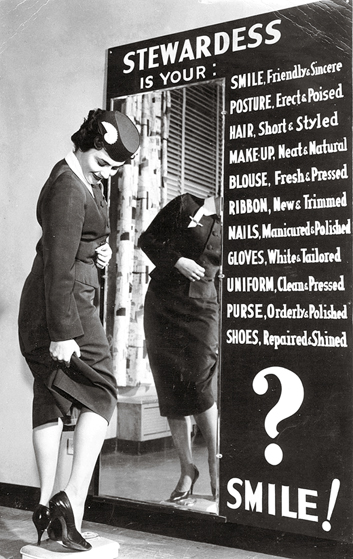Jumpseatnews.com - United Airlines flight attendant resources
Coffee, Tea, or a Knuckle Sandwich?
Source: AirSpaceMag.com
Author: Bettina Haymann Chavanne
 Long gone are the days when airline cabin crews were called “sky girls” or “stewardesses” and considered little more than flying waitresses. Today’s flight attendants are an integral part of the crew—first responders in emergencies that the flying public has braced for since the terrorist attacks of September 11, 2001.
Long gone are the days when airline cabin crews were called “sky girls” or “stewardesses” and considered little more than flying waitresses. Today’s flight attendants are an integral part of the crew—first responders in emergencies that the flying public has braced for since the terrorist attacks of September 11, 2001.
The Federal Aviation Administration recommended in January 2002 that any passenger disturbance, “even those seemingly harmless, should be considered suspicious; it could be a diversion for more serious acts.”
For flight crews dealing with hostile passengers in the past, “it used to be about appeasement,” says Bill McGlashen, assistant to the international president of the Washington-based Association of Flight Attendants, which represents 55,000 flight attendants at 20 airlines. “But there’s been a sea change. We went from being told to cooperate with hijackers until the feds could take over to being trained in defense techniques. Now, it’s ‘Protect the flight deck at all costs.’ ”
The new rules marked a turn in a profession now more than 75 years old. Early flight attendants had to endure unpressurized cabins at turbulent altitudes, sometimes serving meals on their hands and knees because the flight was so rough.
But nothing changed the profession as much as the 2001 attacks, when 25 flight attendants were killed on the four hijacked airplanes—two from American Airlines and two from United. Crews had always been trained in emergency evacuations and inflight medical problems, but preparing to wrestle a terrorist into submission was a new twist. Flight attendants are now taught to protect the flight deck and cabin using whatever tools are at hand.
There are two types of training classes. The Transportation Security Administration offers a voluntary, one-day class in self-defense, taught by federal air marshals, at 10 community colleges around the country. So far, about 1,750 flight crew members, most of them flight attendants, have taken the course—at their own expense—since it began in 2004. Airlines also include self-defense in their required annual training for the nation’s 120,000 flight attendants. But that part of the eight-hour class, taught by flight attendant-instructors, can last from 15 minutes to an hour and a half—too brief to deal with all potential threats, says Candace Kolander, AFA’s air safety, health, and security coordinator. “We’re not saying we should be martial arts experts, but you have to have realistic self-defense training,” she says. “A better way would be to just make the recurrent training longer by a day.”
One important factor in self-defense is how the galley is set up, says McGlashen, an America West flight attendant since 1989. “You have to know where the heavy wine bottles are, the corkscrew, maybe a heavy serving tray. It’s kind of like an old kung fu movie. We also know that our passengers won’t be passive. That kind of vigilance on the part of passengers gives us a sense of empowerment.”
< Return to Latest News
Quick Find
- Unimatic Access
- CCS | Bid Packages
- Flying Together | Webmail
- EmployeeRES | Fare Calculator
- Forms | Paychecks | Benefits | Discounts
- ANP | Leave of Absence | eLearning | CQ
- PED Supplement
- Briefing Sheets | Purser | Tools | FAOM
- Uniforms: Info | Order | Tailors
- Phone Directory | Medical | W2 Form
Travel and Safety
- EmployeeRES | Fare Calculator
- Edit Your Pass Riders | Get Reports
- Jumpseat Travel
- Visas/Passports | Policies | Companions
- Reciprocal Cabin Agreements | ZED
- Known Crewmember | IOR